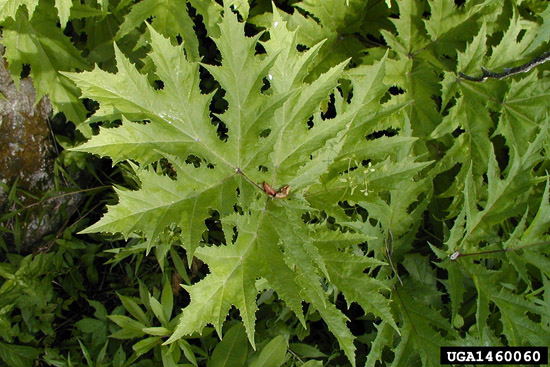Heracleum mantegazzianum
Giant Hogweed
Order: Apiales
Family: Apiaceae
Duration and Habit: Biennial, Perennial herb

Photographer: Kelly Estes
Source: http://hyg.ipm.illinois.edu/article.php?id=80
Description
Giant hogweed (Heracleum mantegazzainum) is from the same family as carrots, Apiaceae. However, unlike carrots, giant hogweed can grow to an average height of 10 to 15 feet in a garden. The leaves are proportionally large with widths up to 5 feet adding mass to the plant that towers over full grown adult humans. Thick stems ranging from 2 to 4 inches in diameter support the large leaves and are covered with purple spots and coarse white hairs. Giant hogweed can be readily identified during the flowering stage from June to July where the plant has several small white flowers covering the tops of the umbrells. The plant is short lived and dies back once seeds have been cast post-blooming, only a taproot remains as evidence of the plant. Giant hogweed overwinters in the form of a hidden taproot until the following spring.
Ecological Threat: Giant hogweed is listed as a federally noxious weed, banning propagation and sale in several states. In addition to being a noxious weed that outcompetes native plants for resources, giant hogweed is also harmful to humans. The clear watery sap that is produced by giant hogweed is known to cause skin photodermatitis in humans, which creates an extreme skin sensitivity to light. Contact with the sap can also form blisters along the skin that itch and burn with a red appearance that later becomes purple. It is strongly recommended to wear gloves whenever handling the plant. Once established in an area giant hogweed successfully diminishes biodiversity by forcing native plant species out of the area due to lack of resources. In some cases it has been known to grow along river banks and cause severe land erosion, further damaging native habitats for plants and wildlife.
Biology & Spread: Giant hogweed is propagated by seed dispersal following the flowering months of June and July. Small white flowers are formed across the 2-2.5 feet width umbrells containing up to 1500 seeds. Once flowering is completed seeds are scattered by wind or water to new areas facilitating further spread of the plant. If seeds land in an area with unfavorable environmental factors, the seeds can remain viable for up to 10 years.
History: Giant hogweed was most likely brought to the United States as an attractive ornamental plant that was easily cultivated in home gardens. The plant is also utilized for its fruit, which is ground to a spice and used for cooking Iranian dishes.
Habitat: Like many invasive plants, giant hogweed is a habitat generalist and can grow in many habitat types within the United States. It is most commonly found in disturbed areas such as roadsides, along train tracks, or along streams and rivers.
Distribution
Native Origin: Caucasus Mountain in southwestern Asia
U.S. Present: IL, MD, ME, MI, NH, NY, OH, OR, PA, VA, VT, WA
Management
Giant hogweed can be removed manually, but it is important to wear protective clothing and eye wear to prevent skin irritation. If manually removing the plant, the entire root system must be disposed of including and ground material contaminated with seeds surround the plant system. Grazing cattle or pigs are helpful in controlling the weed and it is not harmful to the animal is it is to human skin. Chemical treatment is also effective when using herbicides that contain glyphosphate. Herbicides are most successful at eradicating the plant when applied prior to flowering season when the plant is less than 2 feet tall.
Text References
Internet Sources
itis.gov
 Texas Invasive Species Institute
Texas Invasive Species Institute